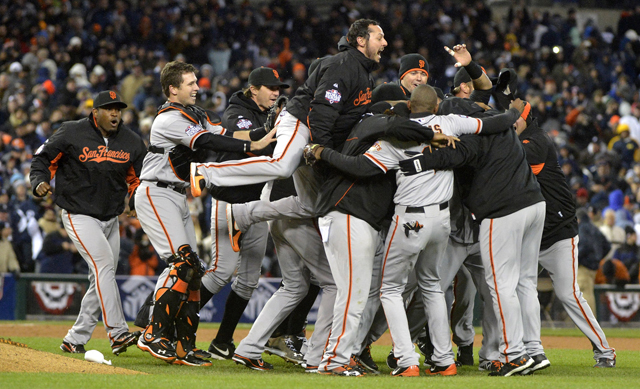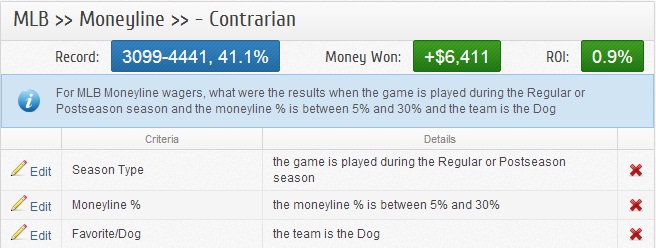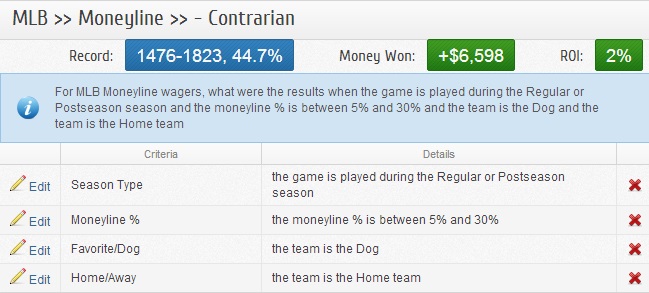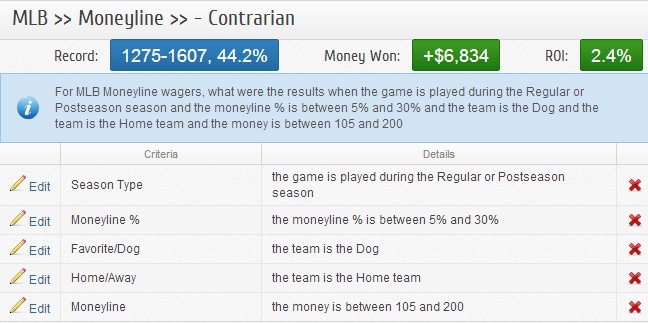
Why is Baseball Betting so Profitable for Sharp Sports Bettors?
With March Madness winding down and the first week of the 2013 MLB season underway, it’s time to turn our attention to arguably the most profitable sport for sharp sports bettors, Major League Baseball. Before we focus on specific MLB betting systems, it’s important to first outline how baseball betting differs from basketball and football.
1. MLB is a moneyline sport
Because baseball is a low scoring game, the majority of money bet on MLB is on the moneyline. With moneylines, bettors are simply wagering on which team will win the game. This differs from football and basketball, where the bulk of money is bet on point spreads.
2. With baseball betting, you don’t need to win 52.4% of your wagers to be profitable
When wagering on basketball and football point spreads, bettors must win 52.4% of their games (assuming a vig of -110) in order to break-even. This can be confusing for bettors trying their hands at baseball for the first time because lower winning percentages can still be extremely profitable when consistently betting moneyline underdogs.
For example, our MLB Best Bets had a win rate of 42.8% last season, but finished +29.35 units on the year (betting 1 unit per play) because of the plus-money payouts of moneyline underdogs.
That means a bettor wagering $100 on each our MLB picks last year finished the season with a profit of $2,935 ($100 x 29.35).
3. The long MLB season provides many opportunities to take advantage of your edge
Some sports fans find the 2,430-game MLB regular season to be long and drawn out. However, for sharp sports bettors, more games means more opportunities to take advantage of their edge and maximize units won.
For example, if your betting system has a return on investment (ROI) of 2%, you’ll average a profit of $2 for every $100 bet placed.
Assuming this 2% ROI, it’s reasonable to expect your system to result in 486 MLB bets and 51 NFL bets over the respective seasons of each sport. (We arrived at these numbers by taking 20% of each sport’s total regular season games played). Remember, the NFL plays 256 games in a normal regular season compared to the MLB’s 2,430.
Even though the ROI is exactly the same for both sports, the sheer volume of wagering opportunities creates a significant difference in the amount of units this system will win for each sport.
A 2% ROI applied to 486 MLB games would result in a profit of +9.72 units, while that same ROI applied to 51 NFL games only earns a profit of +1.02 units.
An MLB bettor wagering $500 on each play ($500 x 9.72 units) would finish the season with a profit of $4,860. Conversely, a $500 NFL bettor earning the exact same ROI would have finished the season with a profit of $510 ($500 x 1.02 units).
The only difference between these two bettors is that a 2% edge in baseball offers exponentially more wagering opportunities than football and, in turn, a profit that’s more than 9.5 times greater for the baseball bettor.
Profitable Baseball Betting Systems
While explaining the advantages that the long MLB season provides, we assumed a betting system with a 2% ROI. For anyone with experience betting on sports, assuming a winning betting system is a lot easier said than done.
As a result, we used our Bet Labs software to show how Betting Against the Public can provide winning betting systems for MLB bettors.
In order to develop this contrarian betting strategy, we started by adding Bet Labs’ Moneyline % and Favorite/Dog Filters to quickly analyze how MLB underdogs receiving less than 30% of moneyline bets had performed over the past eight seasons.
Please note that the Moneyline Betting Percentages used in this analysis represent Sports Insights’ MLB Betting Trends data, which is the average of public betting percentages provided by 7 of the largest offshore sportsbooks.
We recommend that anyone attempting to use or recreate this analysis should use Sports Insights’ betting trends data to ensure they’re accessing betting activity across the entire sports betting marketplace and not the wagering action at just one sportsbook or betting consensus data, which does not represent actual wagers placed.
As you can see in the screenshot below, this system has resulted in a profit of +64.11 units, but the large number of games needed to earn that profit produces a low 0.9% ROI.

However, we can improve ROI by adding Bet Labs’ Home/Away Filter and focusing solely on home teams. This simple filter improves the win percentage to 44.7% and units won to +65.95. While the increase in units is minimal, the drastic decrease in the number of games needed to achieve those results more than doubles the ROI to 2%.

Now that we’ve established the profitability of home underdogs receiving less than 30% of moneyline bets, we can filter this system even further by applying Bet Labs’ Moneyline Filter. This filter allows us to isolate moneyline underdogs of a specific range. For example, the screenshot below includes all MLB home teams that received 30% or less of moneyline bets and closed between +105 and +200 underdogs.

Using a moneyline range of +105 to +200, we once again improved units won while decreasing the total number of games, which bumped ROI to 2.4%.
Not only has this MLB betting system been profitable since 2005, it also breaks down to a very bankroll friendly 360.25 plays per season.

Andre
04/13/2013 at 2:52 pmGreat breakdown on the differences and advantages of mlb betting
Karl
04/16/2015 at 6:12 amJust outstanding! Keep up the great work.
Kyle
03/21/2016 at 4:02 pmWhat does it mean when you state less than 30%? How do I find that when I make wagers?
David Solar
03/21/2016 at 4:16 pmThat information is available to Sportsbook Insider customers or on our free MLB odds page: https://www.sportsinsights.com/free-mlb-odds
tony
04/03/2016 at 3:57 pmare the best time to play these just before game time usually
Cris
05/04/2016 at 6:08 amHey there! I was wondering what the relation between de 2% ROI and the 20% (486/51) of games in the season is. It’s the only thing I didn’t quite understand from the post! Cheers!
David Solar
05/04/2016 at 9:56 amThis season teams receiving less than 30% of moneyline bets have gone 73-99 with +2.67 units won and a 1.5% ROI. However, there has been a huge split between home teams and road teams.
Although home-field advantage has historically been undervalued, that hasn’t been the case this season. You can see the home/away splits for teams getting <30%.
Visitor: 43-49, 17.5%, +$1,607
Home: 30-50, -16.8%, -$1,340